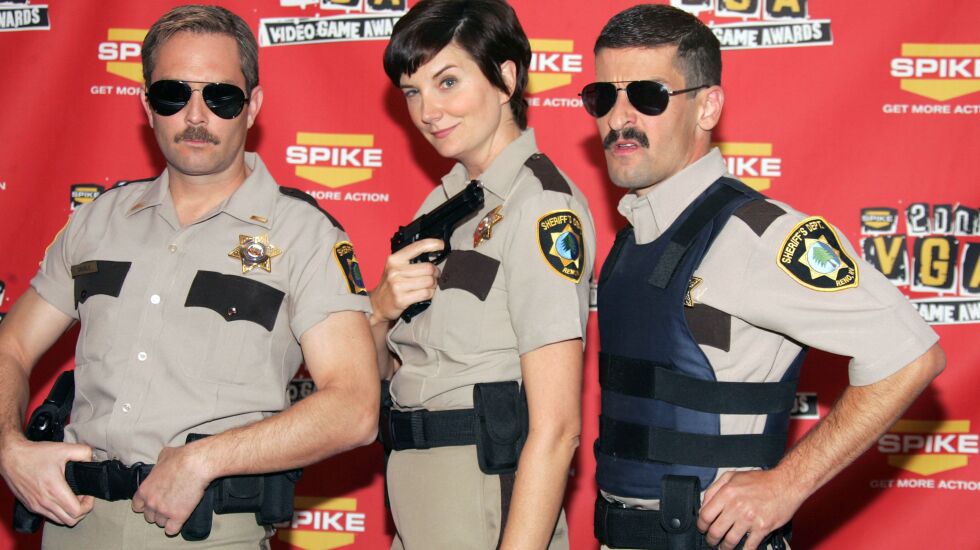
At New York University in the late ’80s and early ’90s, Michael Ian Black was on an 11-member campus comedy group that, he says, scheduled rehearsals for every single day, always for at least a few hours.
More than 30 years and many career advancements later, that yearning for togetherness remains. The group, now called The State and largely still intact, did a show in New York last month, opting to squeeze its eight touring members into one tiny dressing room rather than divvy them up between multiple, larger rooms.
“I don’t know what is wrong with us,” says Thomas Lennon, another member of The State. “We obviously have some weird codependency. We’re terrified to be without the other ones.”
Some might call that friendship forged by decades of comedy collaboration. The State gained national recognition in 1993 when its namesake sketch series aired on MTV. “The State” ran for only four seasons but its sketches — part absurdist, a bit surreal, full of showbiz savvy — have been enshrined in the comedy nerd Smithsonian.
Highlights include a mail carrier-turned-taco deliverer, a child afflicted with “Bologna Feet,” a rambunctious musical theater performance of “Porcupine Racetrack” and Louie, a character whose oft-repeated catchphrase is as unforgettable as it is unprintable.
While The State as an entity has lain dormant for years, its members have almost unanimously found success as comedians, actors, directors, writers and podcast hosts. It has become common for members of The State to pop into each other’s projects. “Wet Hot American Summer,” “Reno 911!,” “Stella” and “Viva Variety” feature a superabundance, but the list continues to include other comedy centerpieces like “Party Down,” “Wanderlust,” “Childrens’ Hospital” and “Brooklyn Nine-Nine.”

The group is currently on tour to celebrate 30 years since “The State” first aired. On Nov. 25 and 26, the Breakin’ Hearts and Dippin’ Balls Tour stops at the Riviera Theatre with new material and reprisals of classic sketches. As a bonus, on the 26th, the group will be handing out stickers as a callback to the 1995 VHS compilation release of “The State: Skits and Stickers*” that included the note “*stickers not included.”
Retroactively, now they are.
The cast include a supermajority of members: the aforementioned Lennon (“Reno 911!,” “Night at the Museum”) and Black (“The Jim Gaffigan Show,” “Another Period”), David Wain (“Role Models”), Kerri Kenney-Silver (“Superstore”), Kevin Allison (“RISK!”), Joe Lo Truglio (“Superbad”), Ken Marino (“Party Down”) and Michael Patrick Jann (“Organ Trail”).
For Black, the tour has offered catharsis from the toll of those early grueling rehearsal schedules. “So much of this tour has been about just being with my friends and doing that in a way that is supportive, because The State in its early days wasn’t always the most supportive group,” Black says. “We were very cutthroat. … It’s nice to revisit this group in a gentler, kinder way.”
Black’s history in Chicago is brief: He was born here and moved to New Jersey when he was 4. However, he still has family in the area, and it was a reverence for Second City, particularly its alumni roster of “Saturday Night Live” cast members, that initially sparked a fascination with comedy
.Lennon, born and raised in Oak Park, caught the Second City bug in his teens. He and his friends would attend the free Friday night improv sets after shows — sitting in the smoking section, of course. He specifically remembers marveling at Dave Pasquesi and witnessing Chris Farley play an early iteration of Matt Foley, the motivational speaker who “lives in a van down by the river.”
Beyond the glitz and glamor of improv comedy at 1 a.m., Lennon had lots of exposure to the arts growing up. His parents took the family to Victory Gardens and the Goodman Theatre every week. At home, he pored over the comedic albums of Oak Park’s own Bob Newhart, mimicking the cadence and memorizing the act verbatim. Plus, his father worked for 40+ years at the Art Institute of Chicago, and this proximity to the city’s arts scene enabled Lennon to learn what it took to be a working actor, a goal he and Black shared before joining The State.
“I don’t think anyone ever thought we’d get rich and famous,” Lennon says. “And if you look at the numbers from the recent State tour, there’s still a lot of us in the group, so we kind of didn’t.”







